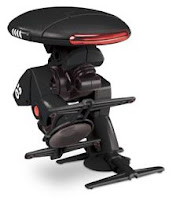I've been searching for a wireless camera solution to second my troublesome and unreliable
X10-based alarm system. This dial-up central is very sensible to interferences and so always called me following a false alarm. Having a way to confirm visually an intrusion would be a good thing for the day this alarm would really go off for a good reason.
I already tried a solution made of a RF-based DVR (the kind using an SD card to store the pictures taken) and some cheap cameras, but the picture quality was far too bad, partly due to the poor signal range. And if was ever to take evidences of an intrusion, I would have seen it days later, when back from holidays... what's the point then ?
In comparison, the IP camera should be able to alert me by email when the intrusion occurs, and give me the option to access it remotely to get further evidences, and call the police the same day.
I found what seems to be the cheapest Pan & Tilt IP camera with Wi-Fi capability on eBay (around 85€).
The device comes unbranded and contains no model reference, however, after some googling, it seems to match with the
IP camera model FI8908W from Foscam.
The manual is correct but could be more complete. For instance, the led blinking rate meaning, which I figured out eventually:
Led blinking Slowly: the camera is searching for an access point.
 Led blinking Fast:
Led blinking Fast: the camera is connected to a LAN by the Ethernet
Led blinking Faster: the camera connected to a wireless access point. This is only possible when the Ethernet cable is unplugged.
The blinking rate should change within the first minute after turning on the camera. If it keeps blinking slowly for longer, you know there is a problem.
The setup is fairly easy once you authorize IE to download unsigned ActiveX controls for your security zone, and also make sure that your anti-virus does not silently block the traffic, which was the case for me with
Avast Antivirus. I had to set the camera address in the exception field of its
network shield.
To my surprise, the technical support from Foscam replied quickly and was friendly and helpful.
The current firmware version (11.14.1.34) does not seem to implement the UPnP properly. When activated, it consistently returns
"UPnP Failed: Errors in Chat with UPnP Device".
According to Foscam, it does not work well at the moment and would be looked after in a future firmware.
Beside that minor detail, the camera is easy to use with a decent user interface. I would however regret that the camera control is using ActiveX . So this product is primarily for M$-Windows users (Apparently there is a working software alternative for Linux called
ZoneMinder but I didn't test it yet.) .
There is a misleading mention of Firefox support on the box, but it's done through an add-on called
IE tab which basically loads a IE page in a Firefox tab...Mmm
The motion detection can be programmed for different times during the week and pictures can be sent automatically to an FTP server and/or and email address at a predefined interval.

It is also possible to interface the camera with an external PIR sensor or alarm system through its RS485 connector.
This green connector on the camera has 4 pins (shortly described in
page 19 of the manual).
- Pins 1 & 2 are for output: typically these would go to the wired inputs of an alarm central like the
SC28 or SC9100. If the camera meets an alarm condition (movement) it would send the signal to the central like a DS10/18 (Door sensor) or MS10/18 (PIR) would. There's also a button on the Web UI that allows to activate pin1 manually.
- Pins 3 & 4 are for input:
You would use these to link wires from a Sensor (DS10/18 have connectors available for that) or any PIR, so if they detect a movement, the camera would, I guess, upload pictures, send an email (as set in camera's Alarm Service Settings) and output +5V on pin 1.
Dynamic DNS can be used for setting up a access from the Internet. It is then possible to log into the camera server and record a video if necessary.
Thanks to the IR leds surrounding the camera lense, the image quality at night is simply as good if not better than during the day.
There is a two-way audio monitoring support on this camera, which means that you can listen from it, and that part is okay, but you could also speak into your PC microphone and a speaker embedded in the camera will relay the sound. The very bad sound quality in this case will make that feature useless.
As a final word, this IP camera is a much better investment that the traditional RF-based cameras. The picture is of better quality despite the similar CMOS sensor
and the added value to your home security system will quickly become obvious.
Pros:+ Good set of features
+ Good image quality day and night
+ Responsive technical support
Cons:-
ActiveX control only (see the latest update about this)- UPnP not properly implemented
- Poor embedded speaker quality
Update #1: I recently purchased a second camera and picked a white version. The brackets enclosing the camera tend to be loose. As a result the motor doesn't always have enough grip to move the camera vertically. I think it comes from the thin plastic casing which seems to be of a lower quality than the black version.
 Update #2:
Update #2: After returning the defective white IP camera, I received another white one, obviously from a more recent batch, the plastic casing is less glossy and of comparable quality to the black model. There is also a small addition at the back of the camera:
a mini jack connector for external audio. Since the embedded speaker is not great, you can now plug a better one in there.
 Useful document:
Useful document: original
IP camera manual (a bit outdated)
.

 After sitting on it for two weeks, the Irish customs finally decided to release the G705 that I ordered on eBay and almost considered lost. The OS was predominantly in Chinese, so I had to change the CDA with tools called "A2 CDA File Generator" and "A2 uploader", so my next update on SEUS would load an European firmware. Then I could really start playing with it:
After sitting on it for two weeks, the Irish customs finally decided to release the G705 that I ordered on eBay and almost considered lost. The OS was predominantly in Chinese, so I had to change the CDA with tools called "A2 CDA File Generator" and "A2 uploader", so my next update on SEUS would load an European firmware. Then I could really start playing with it:










